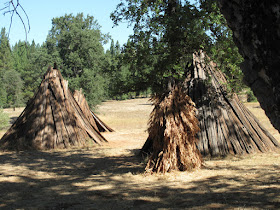 |
| Welcoming Squirrel |
Calaveras Big Trees is a beautiful Park. The park is beautiful with 2 sequoia groves, the North and South. It is truly a majestic walk.
 |
| Empire State Tree |
Giant Sequoias (also known as sierra redwoods) are the largest living things to ever exist on planet earth. The fossil record of redwoods date back 180 million years to the age of the dinosaurs and individual trees can live to over 3,000 years. Once widespread, there are only in 75 groves left on the western slope of the Sierra Nevada Mountains in California.
Calaveras became a State Park in 1931 to preserve the North Grove of giant sequoias. This grove includes the "Discovery Tree", also known as the "Big Stump", the first Sierra redwood noted by Augustus T. Dowd in 1852. This area has been a major tourist attraction ever since, and is considered the longest continuously operated tourist facility in California.
Known as the Empire State, this majestic old tree is now probably the largest sequoia in the North Grove, its base is 30 feet in diameter and at 48 feet above the ground it is still 16 feet in diameter.
 |
| Granite State Tree |
.
 |
| The Hercules Tree |
The Hercules Tree was one of the largest in the grove. It was blown down in a violent windstorm in December 1861. It has been lying here for over a century
 |
| The Father of the Forest |
The Father of the Forest fell long before Euro-Americans discovered this grove of sequoia. Decomposition is so slow because of the tannin in their heartwood. This tree has been lying here between 500-1,000 years. Notice the size of the people down the walk. It is a huge tree!
 |
| Bradley Grove Trail |
 |
| Beaver Creek |
This place is unbelievable and highly recommended.
If you want to check out more pages of the blog . . .Click here!












